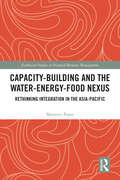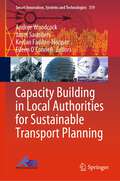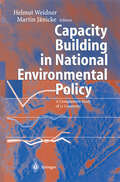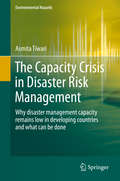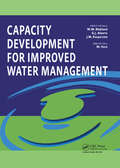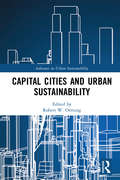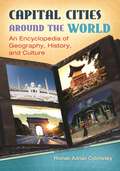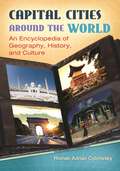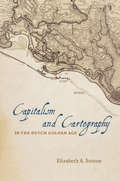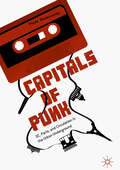- Table View
- List View
The Capability Approach and the Sustainable Development Goals: Inter/Multi/Trans Disciplinary Perspectives (The Routledge Human Development and Capability Debates)
by Brian Vincent IkejiakuThis book demonstrates how the capability approach to human development can contribute to the realisation of the 2015 United Nations Sustainable Development Goals (SDGs).The capability approach dictates that success should not be measured by economic indicators but by people leading meaningful, free, fulfilled, happy, or satisfied lives. Drawing from a range of disciplinary perspectives, this book argues that it is vital that the focus for the SDGs should shift to benefiting the most vulnerable. Case studies from across Asia, Africa, Latin America (Global South), and the United States, the United Kingdom, and Australia (Global North) consider how the capability approach can contribute as a practical framework to achieving the SDGs’ ambitions for social, economic, political, and legal progress.Drawing on insights from a range of disciplines, this book will be of interest to researchers and practitioners from the fields of law, politics, international relations, criminology, international development, sociology, public policy, area studies, and others.
Capacity-Building and the Water-Energy-Food Nexus: Rethinking Integration in the Asia-Pacific (Earthscan Studies in Natural Resource Management)
by Maureen PapasCritically analysing methodologies and objectives of capacity building and the practical linkages required to achieve the Sustainable Development Goals, this book looks at whether nexus thinking offers a systematic approach to combat global environmental problems and facilitate enhanced sustainable development. Building effective and sustainable mechanisms to tackle environmental problems requires in-depth understanding of relationships between natural resources, going beyond conventional policy and siloed decision making. The water energy food nexus has been promoted as a conceptual framework and management tool to facilitate integrated planning and practical linkages to support sustainable development. The author opens this book with an overview of capacity building and reviews the significance of the water energy food nexus, bringing in links to the 2030 Agenda. Climate change is highlighted as a key consideration in any conversation about natural resource use and case studies from Japan, India and China are utilised to show that whist long-term sustainable development practices are being implemented the environmental challenges across the region raise concerns about institutional capacity, economic sustainability and future of the region. Finally, through the lens of capacity building, the book suggests that whilst the water energy food nexus may provide a new approach to sustainable development, it will not be enough to achieve long-term sustainability or extend to the lives of those most affected. The book will be interest to scholars and students within the water, energy and agriculture sectors, sustainability governance and sustainable development. It will also be a valuable resource to those working in governmental organisations and NGOs involved in capacity building and development.
Capacity-Building and the Water-Energy-Food Nexus: Rethinking Integration in the Asia-Pacific (Earthscan Studies in Natural Resource Management)
by Maureen PapasCritically analysing methodologies and objectives of capacity building and the practical linkages required to achieve the Sustainable Development Goals, this book looks at whether nexus thinking offers a systematic approach to combat global environmental problems and facilitate enhanced sustainable development. Building effective and sustainable mechanisms to tackle environmental problems requires in-depth understanding of relationships between natural resources, going beyond conventional policy and siloed decision making. The water energy food nexus has been promoted as a conceptual framework and management tool to facilitate integrated planning and practical linkages to support sustainable development. The author opens this book with an overview of capacity building and reviews the significance of the water energy food nexus, bringing in links to the 2030 Agenda. Climate change is highlighted as a key consideration in any conversation about natural resource use and case studies from Japan, India and China are utilised to show that whist long-term sustainable development practices are being implemented the environmental challenges across the region raise concerns about institutional capacity, economic sustainability and future of the region. Finally, through the lens of capacity building, the book suggests that whilst the water energy food nexus may provide a new approach to sustainable development, it will not be enough to achieve long-term sustainability or extend to the lives of those most affected. The book will be interest to scholars and students within the water, energy and agriculture sectors, sustainability governance and sustainable development. It will also be a valuable resource to those working in governmental organisations and NGOs involved in capacity building and development.
Capacity Building for Sustainable Development
by Capacity Building for Sustainable Development Valentine JamesCapacity building is a topic of intense focus in many industrialized countries. This book explores the theoretical underpinnings of capacity building to sustain the natural, cultural and human resources of communities. It reviews the extensive literature on capacity-building strategies and policies and examines the implications of sustainable development in communities around the world. The book's approach is both theoretical and applied. It offers methods of operationalizing sustainable development and sustainability theories and explores capacity building methods at different levels of government. Successful practices in non-governmental and governmental agency roles are examined. By considering the path towards embracing whole, or partial, sustainability, it provides a comprehensive analysis and examination of how to build capacity in tackling many development problems, especially those linked to infrastructure accumulation and land-use development. Contributors shed light on the overall impact of globalisation and many concepts related to sustainable development and sustainability of the economic socio-cultural and environmental systems. This book: · Examines the links between environment and sustainable development; · Provides models for capacity building; · Considers the role of globalization in sustainable development; · Renders a theoretical and applied examination of the issues; · Provides multidisciplinary and interdisciplinary approaches. This book is recommended for research libraries, for graduate studies in economic development, sustainable development, environmental management; and undergraduate studies relating to developing and emerging countries. It is also useful for government officials, researchers, decision makers and policy analysts involved in sustainable development.
Capacity Building in Local Authorities for Sustainable Transport Planning (Smart Innovation, Systems and Technologies #319)
by Andree Woodcock Janet Saunders Keelan Fadden-Hopper Eileen O’ConnellThis book is conceptualized as being of interest to researchers in the field of sustainable transport, and also those who are working in the field. In the first case it will provide a reference on the state of the art of sustainable transport, and will also include insights into an EU project, how to go about delivering impact, how such projects effect local authorities, etc. Sustainable transport is an extreme growth area; it is highly innovative, with multi-million-pound investments transforming cities. The book will help and encourage resource poor small to medium local authorities catch up and meet their sustainability targets.
Capacity Building in National Environmental Policy: A Comparative Study of 17 Countries
by H. JörgensThis book is the second collection of systematic case studies describing national environmental policies in 17 countries in terms of capacity building (see Appen dix). The OECD defines environmental capacity building as "a society's ability to identify and solve environmental problems. " While various institutions, including UNEP, FAO, World Bank and OECD, have hitherto used the terms environmental capacity and capacity building almost exclusively with reference to developing countries, we have extended the concepts to industrialized countries, as well. The first collection, edited by Martin Janicke, Helge Joergens (both Free University Berlin) and Helmut Weidner (Social Science Research Center Berlin), was pub lished in 1997 under the title "National Environmental Policies - A Comparative Study of Capacity-Building" (Berlin, etc. : Springer Verlag). It included 13 studies of countries. As in the first volume, chapter I presents the conceptual framework underlying the national case studies. It is a slightly shorter version of the corresponding chap ter in volume I. The design of all case studies in the two volumes is largely con gruent with this conceptual framework. Although the various sections of the stud ies do not always have identical titles and subtitles, the central elements of the capacity-building approach have been applied in all cases.
The Capacity Crisis in Disaster Risk Management: Why disaster management capacity remains low in developing countries and what can be done (Environmental Hazards)
by Asmita TiwariHow can a place be built and managed so that it is safe for people to live? Ironically, many governments and citizens keep on asking the same question after every new disaster. Why, even with high levels of investment in increasing government’s capacity to manage disasters, do the impacts of disasters continue to increase? What can the governments do differently? What is the role of local communities? Where should aid agencies invest? This book looks into these critical questions and highlights how current capacity development efforts might be resulting in the opposite—capacity crisis or capability trap. The book provides a new approach for the understanding and the developing of effective local capacity to reduce and manage future disaster impacts.
Capacity Development for Improved Water Management
by Maarten Blokland Guy Alaerts Judith Kaspersma Matt HareThis collection of papers explains how knowledge and capacity development can contribute to improved, effective water management with a digest of lessons learned in the areas of development of tools and techniques, field applications and evaluation. The authors are prominent practitioners, capacity builders and academics within the water and capacity development sectors.Capacity Development for Improved Water Management starts with an introduction and overview of progress and challenges in knowledge and capacity development in the water sector. The next part presents tools and techniques that are being used in knowledge and capacity development in response to the prevailing challenges in the water sector, and a review of experience with capacity change in other sectors. In the third part a number of cases are presented that cover knowledge and capacity development experiences in the water resources and water services sectors. This part also presents experiences on water education for children and on developing gender equity. The fourth part provides experiences with the monitoring and evaluation of knowledge and capacity building.
Capacity Development for Improved Water Management
by M.W. Blokland, G.J. Alaerts, J.M. Kaspersma and M. HareThis collection of papers explains how knowledge and capacity development can contribute to improved, effective water management with a digest of lessons learned in the areas of development of tools and techniques, field applications and evaluation. The authors are prominent practitioners, capacity builders and academics within the water and capacity development sectors.Capacity Development for Improved Water Management starts with an introduction and overview of progress and challenges in knowledge and capacity development in the water sector. The next part presents tools and techniques that are being used in knowledge and capacity development in response to the prevailing challenges in the water sector, and a review of experience with capacity change in other sectors. In the third part a number of cases are presented that cover knowledge and capacity development experiences in the water resources and water services sectors. This part also presents experiences on water education for children and on developing gender equity. The fourth part provides experiences with the monitoring and evaluation of knowledge and capacity building.
Capital Cities and Urban Sustainability (Advances in Urban Sustainability)
by Robert W. OrttungCapital Cities and Urban Sustainability examines how capital cities use their unique hub resources to develop and disseminate innovative policy solutions to promote sustainability. Cities are taking a leading role in defining a sustainable future at a time when national, state, and regional governments in several countries do not provide sufficient leadership. Capital cities stand out among cities as likely leading drivers in the effort to empower sustainable innovation as they provide a hub for connecting a variety of key constituencies. While acknowledging the successes capital cities have achieved, the international, multi-disciplinary contributors to this work discuss how there is room to do more and improve. The promotion of specific sustainability policies in crucial areas such as clean water provision, high tech innovation, public procurement contracting, and improving flood control in capital cities is examined through various global case studies. The examples range from relatively rich capital cities, such as Copenhagen, where the well-financed hub would be expected to succeed in generating sustainable policies, to poorer cities such as Phnom Penh, where such an optimistic outcome can seem less likely.
Capital Cities and Urban Sustainability (Advances in Urban Sustainability)
by Robert W. OrttungCapital Cities and Urban Sustainability examines how capital cities use their unique hub resources to develop and disseminate innovative policy solutions to promote sustainability. Cities are taking a leading role in defining a sustainable future at a time when national, state, and regional governments in several countries do not provide sufficient leadership. Capital cities stand out among cities as likely leading drivers in the effort to empower sustainable innovation as they provide a hub for connecting a variety of key constituencies. While acknowledging the successes capital cities have achieved, the international, multi-disciplinary contributors to this work discuss how there is room to do more and improve. The promotion of specific sustainability policies in crucial areas such as clean water provision, high tech innovation, public procurement contracting, and improving flood control in capital cities is examined through various global case studies. The examples range from relatively rich capital cities, such as Copenhagen, where the well-financed hub would be expected to succeed in generating sustainable policies, to poorer cities such as Phnom Penh, where such an optimistic outcome can seem less likely.
Capital Cities around the World: An Encyclopedia of Geography, History, and Culture
by Roman Adrian CybriwskyThis informative resource is a fascinating compilation of the history, politics, and culture of every capital city from around the world, making this the only singular reference on the subject of its kind.Every country, even the world's youngest nations, has a capital city—a centralized location which houses the seat of government and acts as the hub of culture and history. But, what role do capital cities play in the global arena? Which factors have influenced the selection of a municipal center for each nation? This interesting encyclopedia explores the topic in great depth, providing an overview of each country's capital—its history and early inhabitants, ascension to prominence, infrastructure within the government, and influence on the world around them. The author considers the culture and society of the area, discussing the ethnic and religious groups among those who live there, the major issues the residents face, and other interesting cultural facts.Capital Cities around the World: An Encyclopedia of Geography, History, and Culture features the capital cities of 200 countries across the globe. Organized in alphabetical order by country, each profile combines social studies, geography, anthropology, world history, and political science to offer a fascinating survey of each location.
Capital Cities around the World: An Encyclopedia of Geography, History, and Culture
by Roman Adrian CybriwskyThis informative resource is a fascinating compilation of the history, politics, and culture of every capital city from around the world, making this the only singular reference on the subject of its kind.Every country, even the world's youngest nations, has a capital city—a centralized location which houses the seat of government and acts as the hub of culture and history. But, what role do capital cities play in the global arena? Which factors have influenced the selection of a municipal center for each nation? This interesting encyclopedia explores the topic in great depth, providing an overview of each country's capital—its history and early inhabitants, ascension to prominence, infrastructure within the government, and influence on the world around them. The author considers the culture and society of the area, discussing the ethnic and religious groups among those who live there, the major issues the residents face, and other interesting cultural facts.Capital Cities around the World: An Encyclopedia of Geography, History, and Culture features the capital cities of 200 countries across the globe. Organized in alphabetical order by country, each profile combines social studies, geography, anthropology, world history, and political science to offer a fascinating survey of each location.
Capitalism and Cartography in the Dutch Golden Age
by Elizabeth A. SuttonIn Capitalism and Cartography in the Dutch Golden Age, Elizabeth A. Sutton explores the fascinating but previously neglected history of corporate cartography during the Dutch Golden Age, from ca. 1600 to 1650. She examines how maps were used as propaganda tools for the Dutch West India Company in order to encourage the commodification of land and an overall capitalist agenda. Building her exploration around the central figure of Claes Jansz Vischer, an Amsterdam-based publisher closely tied to the Dutch West India Company, Sutton shows how printed maps of Dutch Atlantic territories helped rationalize the Dutch Republic’s global expansion. Maps of land reclamation projects in the Netherlands, as well as the Dutch territories of New Netherland (now New York) and New Holland (Dutch Brazil), reveal how print media were used both to increase investment and to project a common narrative of national unity. Maps of this era showed those boundaries, commodities, and topographical details that publishers and the Dutch West India Company merchants and governing Dutch elite deemed significant to their agenda. In the process, Sutton argues, they perpetuated and promoted modern state capitalism.
Capitalism and Cartography in the Dutch Golden Age
by Elizabeth A. SuttonIn Capitalism and Cartography in the Dutch Golden Age, Elizabeth A. Sutton explores the fascinating but previously neglected history of corporate cartography during the Dutch Golden Age, from ca. 1600 to 1650. She examines how maps were used as propaganda tools for the Dutch West India Company in order to encourage the commodification of land and an overall capitalist agenda. Building her exploration around the central figure of Claes Jansz Vischer, an Amsterdam-based publisher closely tied to the Dutch West India Company, Sutton shows how printed maps of Dutch Atlantic territories helped rationalize the Dutch Republic’s global expansion. Maps of land reclamation projects in the Netherlands, as well as the Dutch territories of New Netherland (now New York) and New Holland (Dutch Brazil), reveal how print media were used both to increase investment and to project a common narrative of national unity. Maps of this era showed those boundaries, commodities, and topographical details that publishers and the Dutch West India Company merchants and governing Dutch elite deemed significant to their agenda. In the process, Sutton argues, they perpetuated and promoted modern state capitalism.
Capitalism and Cartography in the Dutch Golden Age
by Elizabeth A. SuttonIn Capitalism and Cartography in the Dutch Golden Age, Elizabeth A. Sutton explores the fascinating but previously neglected history of corporate cartography during the Dutch Golden Age, from ca. 1600 to 1650. She examines how maps were used as propaganda tools for the Dutch West India Company in order to encourage the commodification of land and an overall capitalist agenda. Building her exploration around the central figure of Claes Jansz Vischer, an Amsterdam-based publisher closely tied to the Dutch West India Company, Sutton shows how printed maps of Dutch Atlantic territories helped rationalize the Dutch Republic’s global expansion. Maps of land reclamation projects in the Netherlands, as well as the Dutch territories of New Netherland (now New York) and New Holland (Dutch Brazil), reveal how print media were used both to increase investment and to project a common narrative of national unity. Maps of this era showed those boundaries, commodities, and topographical details that publishers and the Dutch West India Company merchants and governing Dutch elite deemed significant to their agenda. In the process, Sutton argues, they perpetuated and promoted modern state capitalism.
Capitalism and Cartography in the Dutch Golden Age
by Elizabeth A. SuttonIn Capitalism and Cartography in the Dutch Golden Age, Elizabeth A. Sutton explores the fascinating but previously neglected history of corporate cartography during the Dutch Golden Age, from ca. 1600 to 1650. She examines how maps were used as propaganda tools for the Dutch West India Company in order to encourage the commodification of land and an overall capitalist agenda. Building her exploration around the central figure of Claes Jansz Vischer, an Amsterdam-based publisher closely tied to the Dutch West India Company, Sutton shows how printed maps of Dutch Atlantic territories helped rationalize the Dutch Republic’s global expansion. Maps of land reclamation projects in the Netherlands, as well as the Dutch territories of New Netherland (now New York) and New Holland (Dutch Brazil), reveal how print media were used both to increase investment and to project a common narrative of national unity. Maps of this era showed those boundaries, commodities, and topographical details that publishers and the Dutch West India Company merchants and governing Dutch elite deemed significant to their agenda. In the process, Sutton argues, they perpetuated and promoted modern state capitalism.
Capitalism and the Social Relationship: An Organizational Perspective
by Agata Stachowicz-Stanusch Hamid KazeroonyThe book examines the changing external environment of organizations. This book explores the contradictions within the global capitalist system and their consequences to assess and find ways in creating new knowledge for managers/leaders to reorient themselves in appropriate restructuring of organizations to better serve their stakeholders.
Capitalism Created the Climate Crisis and Capitalism Will Solve It: The Market Forces Catalyzing a Climate Technology Renaissance
by Kentaro KawamoriCreative and practical free-market solutions to climate change In Capitalism Created the Climate Crisis and Capitalism Will Solve It: The Market Forces Catalyzing a Climate Technology Renaissance, distinguished author Kentaro Kawamori delivers a fascinating and timely exploration of the interplay between capitalism and climate change. He explains how the capitalist system helped to contribute to the current crisis of global warming and how that same system will help to end it. In the book, the author discusses the enormous impact of the climate crisis and how the government, the modern finance industry, the fossil fuel industry, and others combined to accelerate the warming of the world. He then considers the roles those same players will play to reverse this effect in the coming years. You’ll also find: Discussions of how climate tech innovations will transform the economy and how technology disruptors will become involved in the process The ways the energy industry will change to incorporate the realities and consequences of a warming climate Explorations of the incentives created by free market structures and how to include climate stakeholders in the discussionAn engaging and exciting new resource for anyone interested in the intersection of economics, business, and the environment, Capitalism Created the Climate Crisis and Capitalism Will Solve It contains practical and thoughtful climate prescriptions for a world desperately in need of them.
Capitalism Created the Climate Crisis and Capitalism Will Solve It: The Market Forces Catalyzing a Climate Technology Renaissance
by Kentaro KawamoriCreative and practical free-market solutions to climate change In Capitalism Created the Climate Crisis and Capitalism Will Solve It: The Market Forces Catalyzing a Climate Technology Renaissance, distinguished author Kentaro Kawamori delivers a fascinating and timely exploration of the interplay between capitalism and climate change. He explains how the capitalist system helped to contribute to the current crisis of global warming and how that same system will help to end it. In the book, the author discusses the enormous impact of the climate crisis and how the government, the modern finance industry, the fossil fuel industry, and others combined to accelerate the warming of the world. He then considers the roles those same players will play to reverse this effect in the coming years. You’ll also find: Discussions of how climate tech innovations will transform the economy and how technology disruptors will become involved in the process The ways the energy industry will change to incorporate the realities and consequences of a warming climate Explorations of the incentives created by free market structures and how to include climate stakeholders in the discussionAn engaging and exciting new resource for anyone interested in the intersection of economics, business, and the environment, Capitalism Created the Climate Crisis and Capitalism Will Solve It contains practical and thoughtful climate prescriptions for a world desperately in need of them.
Capitalism, Degrowth and the Steady State Economy: Debating Future Economic Models (Palgrave Insights into Apocalypse Economics)
by Theodore P. LianosThis book examines the contemporary state of the capitalist economyand its future trajectory in a world characterized by multiple crises from population growth to ecological damage. Setting an understanding of modern capitalism in global historical context, chapters consider the uncertainty of capitalism’s future and argues that capitalism must adapt dramatically to survive.. The book examines the major problems that a capitalist system faces, including inequality, organized crime, uncontrolled technological development, polarizing geopolitics, food security and climate change. To address these multifaceted challenges andminimize the impact of capitalism in exacerbating them, the book discusses the potential viability of a ‘steady state’ economic model and a de-growth approach to the global economy. It also considers various alternative models for the future, including eco-socialism and participatory socialism. This book deftly weaves together perspectives on a wide variety of issues and will be a useful resource for scholars interested in Marxist economics and heterodox economics, political economy, economic development and economic thought.
The Capitalist Commodification of Animals (Research in Political Economy #35)
by Brett ClarkWhile animal suffering and abuse have taken place throughout history, the alienation of humanity from nature caused by the development of capitalism - by the logic of capital and its system of generalized commodity production - accelerated and increased the depredations in scope and scale. The capitalist commodification of animals is extensive. It includes, but is not limited to: livestock production in concentrated animal feeding operations leather and fur production the ivory trade in which tusks are used for 'traditional medicines; or carved into decorative objects entertainment such as in zoos, marine parks, and circuses laboratory experimentation to test medicines, beauty products, pesticides, and other chemicals the pursuit of trophy hunting, sometimes on canned farms and sometimes in the wild bioengineering of livestock and of animals used in laboratories The contributors to this special issue of Research in Political Economy provide insightful analyses that address the historical transformations in the material conditions and ideological conceptions of nonhuman animals, alienated speciesism, the larger ecological crisis that is undermining the conditions of life for all species, and the capitalist commodification of animals that results in widespread suffering, death, and profits. This book is a must-read not only for political economists, but also for researchers interested in animal studies, environmentalism, and sustainability.
The Capitalist Commodification of Animals (Research in Political Economy #35)
by Brett Clark Tamar Diana WilsonWhile animal suffering and abuse have taken place throughout history, the alienation of humanity from nature caused by the development of capitalism - by the logic of capital and its system of generalized commodity production - accelerated and increased the depredations in scope and scale. The capitalist commodification of animals is extensive. It includes, but is not limited to: livestock production in concentrated animal feeding operations leather and fur production the ivory trade in which tusks are used for 'traditional medicines; or carved into decorative objects entertainment such as in zoos, marine parks, and circuses laboratory experimentation to test medicines, beauty products, pesticides, and other chemicals the pursuit of trophy hunting, sometimes on canned farms and sometimes in the wild bioengineering of livestock and of animals used in laboratories The contributors to this special issue of Research in Political Economy provide insightful analyses that address the historical transformations in the material conditions and ideological conceptions of nonhuman animals, alienated speciesism, the larger ecological crisis that is undermining the conditions of life for all species, and the capitalist commodification of animals that results in widespread suffering, death, and profits. This book is a must-read not only for political economists, but also for researchers interested in animal studies, environmentalism, and sustainability.
Capitals of Punk: DC, Paris, and Circulation in the Urban Underground
by Tyler SonnichsenCapitals of Punk tells the story of Franco-American circulation of punk music, politics, and culture, focusing on the legendary Washington, DC hardcore punk scene and its less-heralded counterpart in Paris. This book tells the story of how the underground music scenes of two major world cities have influenced one another over the past fifty years. This book compiles exclusive accounts across multiple eras from a long list of iconic punk musicians, promoters, writers, and fans on both sides of the Atlantic. Through understanding how and why punk culture circulated, it tells a greater story of (sub)urban blight, the nature of counterculture, and the street-level dynamics of that centuries-old relationship between France and the United States.
Captain Cook
by Alistair MacLeanOn the 250th anniversary of Captain Cook’s successful navigation to the coast of Australia, this is Alistair MacLean’s absorbing story of one of Britain’s great national heroes, from his obscure beginnings to his sudden and violent death at the age of fifty-one. When James Cook was hacked to death by Hawaiian islanders on 14 February 1779, he was already considered the greatest explorer of his age. Born in obscurity but gripped by a boundless passion for new horizons, he became the greatest combination of seaman, explorer, navigator, and cartographer that the world had ever known. He still is. He had driven himself mercilessly, and his men likewise, and yet the surgeon’s mate on the Resolution was able to write: ‘In every situation he stood unrivalled and alone; on him all eyes were turned; he was our leading star, which at its setting left us involved in darkness and despair’. Between 1768 and 1779, Captain Cook circumnavigated the globe three times in voyages of discovery that broke record after record of exploration, endurance, and personal achievement. He explored and charted the coasts of New Zealand, landed in Botany Bay, explored the Pacific, mapped its islands, and travelled further south than any man before him; he explored the Great Barrier Reef and travelled thousands of miles north to tackle the North-West Passage. He excelled in all aspects of his craft and inspired in his men an affection for him and an enthusiasm for his undertakings that provoked constant loyalty and unfailing endeavour in frequently savage conditions. Alistair MacLean presents a graphic and lively account of this great explorer, his three amazing voyages and the adventures that befell him, his crews, and his ships in lands that until he sailed were in many cases unknown. Cook’s life was a resounding success and the story of it is a thrilling exemplification of his own description of himself as a man ‘who had ambition not only to go farther than anyone had done before, but as far as it was possible for man to go’.

